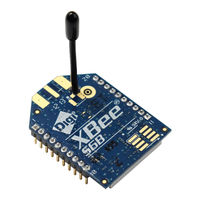Digi XB2B-WFUT-001 Manuals
Manuals and User Guides for Digi XB2B-WFUT-001. We have 1 Digi XB2B-WFUT-001 manual available for free PDF download: User Manual
Digi XB2B-WFUT-001 User Manual (200 pages)
Wi-Fi RF Module
Brand: Digi
|
Category: Wireless Router
|
Size: 2 MB
Table of Contents
Advertisement
Advertisement
